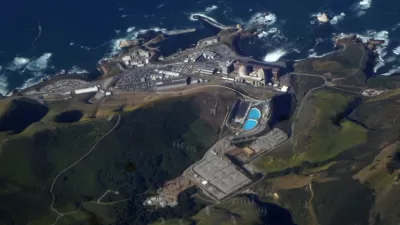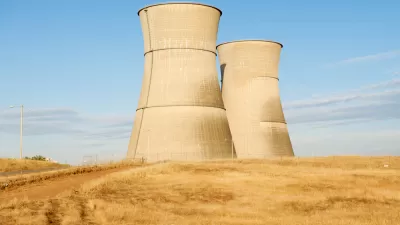Gov. Gavin Newsom has notified the U.S. Department of Energy of his interest in using funding included in the Infrastructure Investment and Jobs Act to extend the life of the Diablo Canyon nuclear power plant slated to close in three years.

In "a stunning reversal, coming after a decades-long drive to shutter PG&E Corp.’s Diablo Canyon nuclear plant over fears it’s one earthquake away from catastrophe," Mark Chediak and Will Wade report for Bloomberg News on May 25 that the state "is reconsidering plans to close its only remaining set of reactors as California struggles to run its power grid with fewer fossil-fuel plants."
Related post: The Only Remaining Nuclear Power Plant in California Will Close, June 23, 2016.
While the facility’s fate remains uncertain, the fact that solar- and wind-loving California is even talking about extending its life marks a turning point in the global debate over nuclear power. It comes as the state has moved aggressively to shutter natural-gas facilities, leaving it in danger of blackouts during heat waves.
Funds Available in Infrastructure Investment and Jobs Act
The passage of the Infrastructure Investment and Jobs Act (previously known as the bipartisan infrastructure framework) last November, specifically the inclusion of the $6 billion Civil Nuclear Credit Program to extend the life of nuclear power plants unable to compete with cheaper power from natural gas and renewable power facilities, influenced California Gov. Gavin Newsom's reconsideration of the decision made by PG&E six years ago to close the state's last nuclear power plant.
Related posts:
- $6 Billion to Keep Uncompetitive Nuclear Plants Alive, May 11, 2022
- What Does the Closure of So Cal's Nuclear Power Plant Mean for the State's Energy Future? July 19, 2013]
"In a letter to US Secretary of Energy Jennifer Granholm, California Governor Gavin Newsom’s office said federal money will be a key factor as it evaluates whether it can temporarily extend the life of the Diablo Canyon plant beyond its planned 2025 retirement," reported Chediak separately on May 24.
In the letter Monday to the US Energy Department, Newsom cabinet secretary Ana Matosantos said the state was considering preserving Diablo Canyon due to the planned retirements of other power generators as well as expected clean-power projects that have been delayed.
Related post: Opinion: Replacing Nuclear Plants Amounts to 'Treadmill Decarbonization,' July 25, 2021
However, the decision to apply for funding from the new bailout program to prolong the life of the 2,256 MW power plant, the state's largest, would have to come from the owner, the Pacific Gas and Electric Company (PG&E), California's largest utility.
PG&E Corp., which operates the plant, is willing to consider all options for it, said spokeswoman Suzanne Hosn. “We are open to applying for Department of Energy funding given the potential savings it could represent for our customers as the state considers various options to support reliability in California,” Hosn said.
A problem
According to a May 18 news release by the Environmental Working Group, the plant technically doesn't qualify for the credit program.
But the lifeline may violate DOE guidance, which says only nuclear plants in states with deregulated energy can apply for a share of the $6 billion Civil Nuclear Credit Program, a fund designed to help nuclear reactors keep operating. Diablo Canyon is in California, which fully regulates utility power generation, so it shouldn’t be eligible.
[See 'Category 1—Compete in a Competitive Electricity Market' in the "Notice of Intent and Request for Information Regarding Establishment of a Civil Nuclear Credit Program," Federal Register, 02/15/2022]
The group makes clear their position on prolonging the life of the controversial power plant.
“Even by PG&E’s own history of billion-dollar misguided spending sprees, throwing taxpayers’ money away to keep the unsafe Diablo Canyon nuclear plant on life support has to be one of the worst,” said EWG President and California resident Ken Cook.
The letter [pdf via E&E News] by the Governor's Office on May 23 asks Granholm to make changes to the program's criteria to allow PG&E to apply for the funding.
"We appreciate DOE’s consideration of these suggestions and request a prompt response as this information is critical for California’s due diligence efforts and will help inform the state’s actions to maintain energy reliability as it continues leading in the transition to clean energy," wrote Matosantos in her closing paragraph.
Electricity reliability at the heart of potential application
"Otherwise, Matosantos wrote, California's Diablo Canyon Power Plant might not qualify — and it needs the money to stay open and ensure the lights stay on in the nation's most populous state," wrote E&E News West Coast bureau chief Anne C. Mulkern on May 25.
Two days earlier, Mulkern wrote in Scientific American on the potential for blackouts in California for "the next five summers" due to threats to electricity reliability posed by "extreme heat and other climate change impacts."
Deadline extended
The initial deadline for the first application for funding for the nuclear credit program had been May 19. On May 18, "two days after two industry trade groups, Edison Electric Institute and Nuclear Energy Institute, sent a letter to Energy Secretary Jennifer Granholm requesting the extension on behalf of their members," the Department of Energy extended the application period to July 5, reported Reuters.
Related:
- Three posts on the Diablo Canyon Power Plant: May 11, 2022, July 25, 2021, June 23, 2016
FULL STORY: California, Long Leery of Nuclear Power, Joins Bid to Save It

Alabama: Trump Terminates Settlements for Black Communities Harmed By Raw Sewage
Trump deemed the landmark civil rights agreement “illegal DEI and environmental justice policy.”

Study: Maui’s Plan to Convert Vacation Rentals to Long-Term Housing Could Cause Nearly $1 Billion Economic Loss
The plan would reduce visitor accommodation by 25% resulting in 1,900 jobs lost.

Planetizen Federal Action Tracker
A weekly monitor of how Trump’s orders and actions are impacting planners and planning in America.

Waymo Gets Permission to Map SF’s Market Street
If allowed to operate on the traffic-restricted street, Waymo’s autonomous taxis would have a leg up over ride-hailing competitors — and counter the city’s efforts to grow bike and pedestrian on the thoroughfare.

Parklet Symposium Highlights the Success of Shared Spaces
Parklets got a boost during the Covid-19 pandemic, when the concept was translated to outdoor dining programs that offered restaurants a lifeline during the shutdown.

Federal Homelessness Agency Places Entire Staff on Leave
The U.S. Interagency Council on Homelessness is the only federal agency dedicated to preventing and ending homelessness.
Urban Design for Planners 1: Software Tools
This six-course series explores essential urban design concepts using open source software and equips planners with the tools they need to participate fully in the urban design process.
Planning for Universal Design
Learn the tools for implementing Universal Design in planning regulations.
Caltrans
Smith Gee Studio
Institute for Housing and Urban Development Studies (IHS)
City of Grandview
Harvard GSD Executive Education
Toledo-Lucas County Plan Commissions
Salt Lake City
NYU Wagner Graduate School of Public Service





























